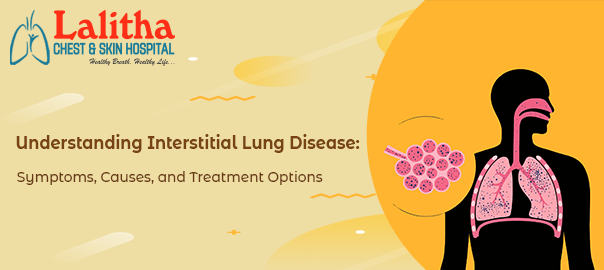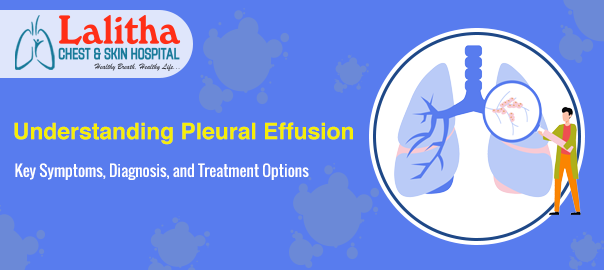Interstitial Lung Disease (ILD) is an umbrella term used to describe a group of lung disorders that affect the interstitium, the tissue, and the space around the air sacs of the lungs. These disorders can lead to lung scarring (fibrosis), which can cause difficulty breathing and reduced oxygen supply to the blood.
Dr. Raj Kumar Korra, the best chest specialist in Karimnagar, recommends managing your Interstitial Lung Disease with regular follow-ups, prescribed medications to reduce inflammation or slow lung scarring, and lifestyle changes such as quitting smoking and incorporating pulmonary rehabilitation to maintain optimal lung function.
While ILD is a chronic condition, understanding its symptoms, causes, and available treatment options is crucial for effective management and improving quality of life. In this blog, with insights from Dr. Raj Kumar Korra at Lalitha Chest and Skin Hospital, we provide comprehensive information. Read on to learn more:
Common Symptoms of Interstitial Lung Disease:
The symptoms of ILD can vary depending on the severity of the condition and the underlying cause, but the most common include:
- Shortness of Breath (Dyspnea): Initially noticeable during physical activity, this symptom can progress to a constant struggle for breath, even while resting.
- Dry, Persistent Cough: Unlike a cough caused by infection, this cough is non-productive (no mucus) and tends to worsen over time.
- Fatigue: Due to reduced oxygen levels, patients often feel extremely tired even after minimal exertion.
- Weight Loss: In some cases, unexplained weight loss occurs due to the body’s struggle with oxygen deprivation.
- Clubbing of Fingers: In more advanced stages, the fingertips may become enlarged and rounded, a condition known as clubbing.
- Chest Discomfort: Some patients may experience mild pain or tightness in the chest, particularly during breathing.
These symptoms tend to develop gradually, but if left untreated, they can significantly worsen, leading to severe complications like respiratory failure.
What Causes Interstitial Lung Disease?
ILD has many potential causes, including environmental exposures, autoimmune diseases, and certain medications. Some common causes include:
- Occupational and Environmental Hazards: Long-term exposure to harmful substances like asbestos, silica dust, coal dust, mold, and bird droppings can damage the lungs and lead to ILD. This is often referred to as pneumoconiosis or hypersensitivity pneumonitis depending on the cause.
- Autoimmune and Connective Tissue Diseases: Conditions such as rheumatoid arthritis, scleroderma, and lupus can cause inflammation and scarring of the lung tissue. These conditions affect the body’s immune system and lead to progressive lung damage.
- Medications and Radiation Therapy: Some chemotherapy drugs, antibiotics, and heart medications can cause ILD as a side effect. Additionally, radiation therapy to the chest for cancer treatment can lead to lung damage over time.
- Idiopathic Causes: In many cases, the exact cause of ILD cannot be identified, known as Idiopathic Pulmonary Fibrosis (IPF). This condition has no clear trigger but leads to rapid lung scarring and a significant decline in lung function.
Diagnosing Interstitial Lung Disease:
Diagnosing ILD can be challenging due to the wide range of symptoms and causes. Doctors use a combination of tools to diagnose and understand the extent of lung damage:
- Imaging Tests: A chest X-ray or high-resolution CT scan is usually the first step in diagnosing ILD. These tests can show scarring, inflammation, or other abnormalities in the lungs.
- Pulmonary Function Tests: These tests measure how well your lungs are working by assessing airflow and oxygen levels in the blood.
- Lung Biopsy: In some cases, a small sample of lung tissue may be taken to confirm the diagnosis and determine the type of ILD.
- Blood Tests: These help rule out infections, check for autoimmune conditions, or assess how well the organs are functioning.
Treatment for Interstitial Lung Disease:
While there is no cure for ILD, treatment focuses on slowing disease progression, managing symptoms, and improving the patient’s quality of life. Treatment plans often include a combination of the following:
- Medications:
- Anti-inflammatory drugs: Corticosteroids are often prescribed to reduce lung inflammation.
- Antifibrotic drugs: Medications like pirfenidone and nintedanib may help slow down lung scarring, particularly in idiopathic pulmonary fibrosis (IPF).
- Immunosuppressants: For autoimmune-related ILD, medications that suppress the immune system can reduce damage to lung tissue.
- Oxygen Therapy: Supplemental oxygen is often recommended for patients with low oxygen levels. It helps alleviate symptoms like shortness of breath, increases energy levels, and improves quality of life.
- Pulmonary Rehabilitation: This program includes breathing exercises, physical activity, and education on lung health. It can help improve lung function and endurance, making daily activities easier to perform.
- Lung Transplant: In severe cases of ILD where lung function has significantly deteriorated, a lung transplant may be considered. This option is typically reserved for patients who are otherwise healthy and meet strict criteria for the surgery.
- Lifestyle Changes: Avoiding environmental triggers like smoking, dust, and chemicals, as well as staying active within the limits of your condition, can make a significant difference in managing ILD.
Living with Interstitial Lung Disease:
Managing ILD requires a multifaceted approach that includes medical care, lifestyle adjustments, and emotional support. Patients often benefit from joining support groups where they can connect with others who understand their experience. Regular monitoring and close communication with healthcare providers are essential to staying on top of any changes in symptoms.
While ILD can be a life-changing diagnosis, the right treatment plan can slow disease progression and help patients live more comfortably. With advances in medications and care options, many individuals with ILD can maintain a good quality of life for years to come.
If you’re in Karimnagar searching for an ‘interstitial lung disease treatment,’ ‘best respiratory doctor near me,’ or ‘pulmonologist specialist near me,’ let us save you time by booking an appointment today with the renowned Dr. Raj Kumar Korra.
Lalitha Chest and Skin Hospital is the leading chest hospital in Karimnagar, boasting an exceptional track record in treating all types of Interstitial Lung Disease. With the expertise of Dr. Raj Kumar Korra, a respected lung doctor nearby in the area, we provide complete support for a wide range of lung-related concerns. To schedule your appointment, please visit our website: https://lalithachestandskinhospital.com/



